
FROM THE SIMPLE TO THE SPECTACULARHOW TO MAKE CARAMELS, FUDGE, HARD CANDY, FONDANT, TOFFEE, AND MORE!
Elizabeth LaBau



Some children collect baseball cards. Others collect dolls. When I was a child, I collected candy.
Every Halloween, I insisted on using an old pillowcase to gather my candy instead of a novelty candy bucket, because the pillowcase could hold so much more loot. It was thrilling to watch my candy collection grow as I roamed the neighborhood trick-or-treating, and I wouldnt stop knocking on doors until I could barely lift the pillowcase from the ground. After I shuffled home, hunched under the weight of my haul, I would carefully hide the candy in my room and hoard it like a miser for months. My goal was always to make it last until Easter, when I would receive a fresh supply of sweets.
Now that I am an adult, I have a greater appreciation for dark chocolate and less of a fondness for guzzling straight sugar, but not much else has changed. I still have an unapologetic love of candy, and if someone were to hand me a pillowcase full of chocolate today, I would gladly, gleefully, accept.
Fortunately, I am no longer dependent on the kindness of strangers to replenish my candy supply. In my job as a recipe developer, I am lucky enough to be able to make my own candy whenever a craving strikes. The basic thrill of simply eating sugar has been replaced by the joy of working with sugar to invent my own candy creations, and I hope to share this same joy with you.
Making candy at home is a magical process. Even after years of experience, it is still amazing to me that simply boiling a few ingredients together can produce luminous lollipops, and that whisking cream and chocolate together can yield soft, rich truffles. If you are new to candy making, some steps might seem intimidating, but I want to assure you that not only is it possible to make gorgeous, delicious, professional-quality candies in your home kitchen, but it is also fun.
Whether you are an experienced candy maker looking for new ideas and inspiration or a novice seeking a step-by-step candy-making guide, there is something in this book for you. introduction to common candy ingredients and candy-making equipment. Chapter 2 will take you through some of the fundamental techniques for working with sugar and chocolate, like how to properly boil sugar and how to temper chocolate. You may be tempted to skip this chapter to get to the recipes fasterresist! Knowing these skills is crucial to candy-making success, and it is important to be comfortable with them.
is where youll find the recipes for everything from sugar candies to caramels, chocolates to marshmallows, toffees to truffles. I have included a mix of classic recipes and contemporary flavor combinations that are meant to get you started and spur your own imagination. As you master the basic techniques and foundational elements of each recipe, I hope you will be inspired to experiment with variations and create your own unique candy combinations.
Each recipe chapter also has a troubleshooting section that addresses common problems with that type of candy, and offers solutions. In my years of candy making I have had just about every kitchen failure you can imagine, and I probably even invented a few new ones. Making a failed batch of candy can be frustrating, and I want to save you from that same fate by pointing out potential trouble areas and typical mistakes.
Finally, when you are an expert candy maker, the only thing left is to gild the lilyor the chocolate, as it werewith fancy decorating techniques! offers a variety of decorating ideas for creating beautiful and unique truffles, caramels, marshmallows, and more. There are also recipes that use sugar and chocolate skills from previous chapters to make edible garnishes like spun sugar and chocolate bowls.
After you have spent time cooking from this book, I hope you will be inspired to grab your metaphorical pillowcase and fill it with candy recipes you love and want to add to your personal collection!

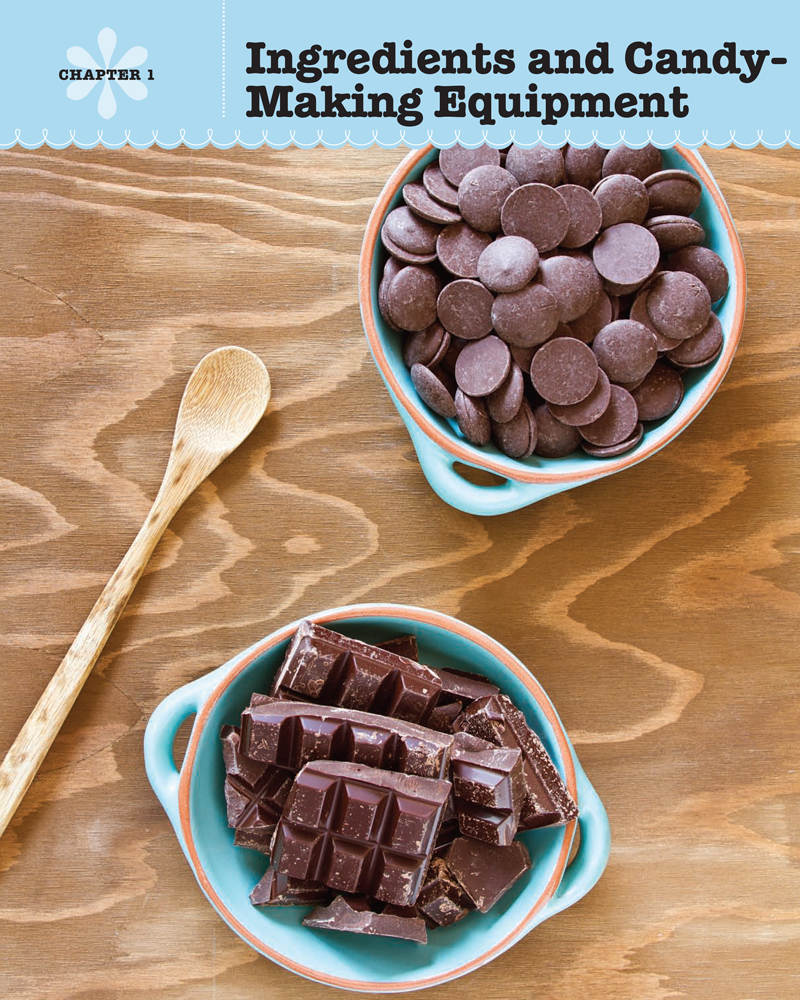
 Ingredients
Ingredients 
One of the easiest things you can do to ensure excellent candies is to use fresh, quality ingredients. Before you clutch your wallet in horror, understand that quality does not necessarily equate to the most expensive gourmet foods. Choosing good ingredients can be as simple as knowing the most suitable types of butter and cream to buy, when to use fresh versus frozen fruit, and the optimal chocolate for your recipe of choice. This section will introduce you to the most common candy ingredients and make a few purchasing recommendations when appropriate.
.... SWEETENERS ....
Granulated sugar: Granulated sugar is the product most people think of when they hear the word sugar. Also known as white sugar or table sugar, it is the most common ingredient in candy making. It is made by refining the sweet juice from sugar cane or, increasingly, beets, into fine white crystals. Sugar that is made from pure sugar cane is usually labeled cane sugar, but sugar that is made from beets or a combination of beet and cane sugars is often unspecified and simply called sugar. I am a cane sugar puristin my experience, beet sugar does not behave predictably and can produce inconsistent, undesirable results when cooked to high temperatures. I recommend buying only sugar that is clearly labeled as coming from sugar cane.
Brown sugar: Brown sugar is actually granulated sugar that has molasses added back in after processing. Brown sugar is available in light and dark varieties; light brown sugar, which has a milder flavor, should be used to make the recipes in this book. When measuring brown sugar by volume, always pack it tightly into the measuring cup to get an accurate measurement.
Powdered sugar: Also known as confectioners sugar or icing sugar, powdered sugar is made from finely pulverized granulated sugar. It often contains a small amount of cornstarch to prevent clumping. Because it easily absorbs moisture from the air, it should always be stored in an airtight container and be sifted before use to remove any lumps.
Corn syrup: Corn syrup has developed a bad reputation. It is true that high-fructose corn syrup has unnecessarily weaseled its way into many packaged foods, but in my opinion corn syrup still has a place in the candy makers kitchen. It is an invaluable tool that prevents crystallization in sugar candies, and it improves the texture of fudges and truffles. Corn syrup comes in two varieties, light and dark corn syrup. Light corn syrup is more refined and has no discernible flavor, while dark corn syrup has an amber color and a caramel taste. The two are not interchangeable, and all of the recipes in this book call for light corn syrup.
Next page

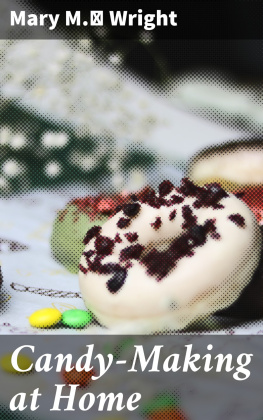
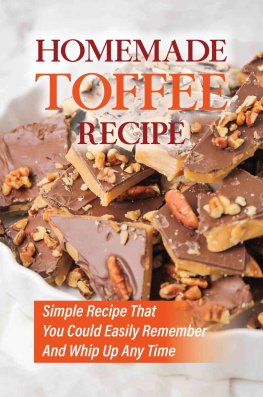

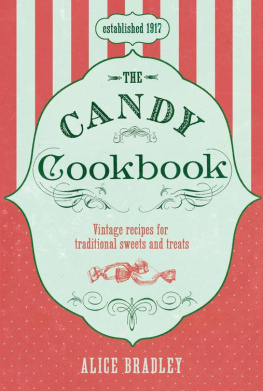
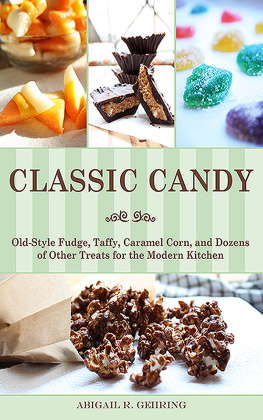
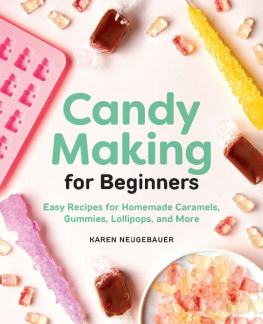
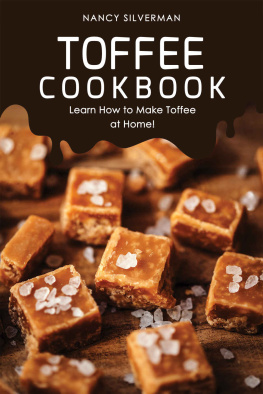
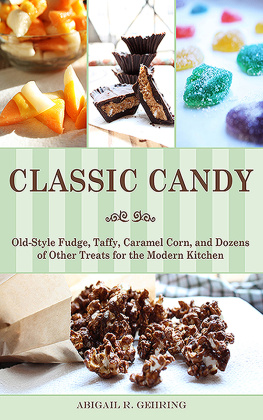







 Ingredients
Ingredients